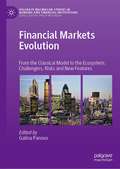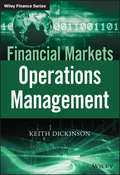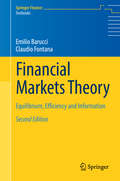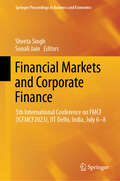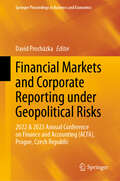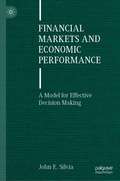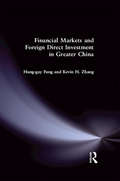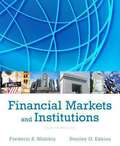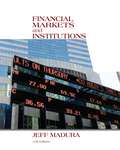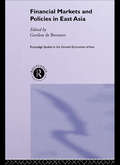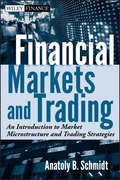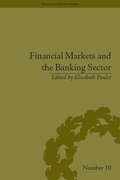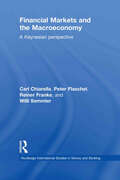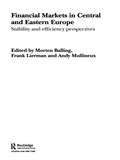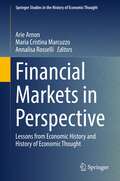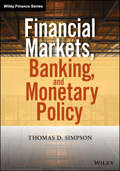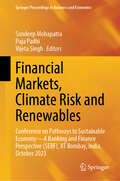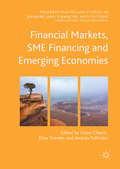- Table View
- List View
Financial Markets Evolution: From the Classical Model to the Ecosystem. Challengers, Risks and New Features (Palgrave Macmillan Studies in Banking and Financial Institutions)
by Galina PanovaInfluenced by technological innovation, banks and their businesses are changing dramatically. This book explores the transformation and prospects of financial market institutions (banks, insurance companies, pension funds and microfinance organizations) in the context of the development of financial innovation, financial engineering and financial technologies, taking into account risks and new opportunities for development. It presents new approaches to the sustainable development of financial and credit institutions, taking into account the risk management and crisis management of their activities in the macro and microeconomic environment. Contributors from Russia, Kazakhstan, Azerbaijan, Mongolia, Ireland and Italy present their expert opinions on the practice of financial intermediaries in the conditions of economic transformation under the influence of the 4th Industrial Revolution and the Covid-19 pandemic. This book includes some of the key debates in this area including the genesis of financial markets in the paradigm of economic digitalization, the evolution of financial intermediaries from the classical model to the ecosystem, and the regulation of neo-banks. The book will be of interest to academics and practitioners in various spheres of theoretical and empirical knowledge, including economics, finance and banking, who are interested in investigation of the complex of fundamental (international and domestic) trends in the development of financial intermediation in the globalized financial markets.
Financial Markets Operations Management
by Keith DickinsonA comprehensive text on financial market operations managementFinancial Market Operations Management offers anyone involved with administering, maintaining, and improving the IT systems within financial institutions a comprehensive text that covers all the essential information for managing operations. Written by Keith Dickinson--an expert on the topic--the book is comprehensive, practical, and covers the five essential areas of operations and management including participation and infrastructure, trade life cycle, asset servicing, technology, and the regulatory environment. This comprehensive guide also covers the limitations and boundaries of operational systems and focuses on their interaction with external parties including clients, counterparties, exchanges, and more.This essential resource reviews the key aspects of operations management in detail, including an examination of the entire trade life cycle, new issue distribution of bonds and equities, securities financing, as well as corporate actions, accounting, and reconciliations. The author highlights specific operational processes and challenges and includes vital formulae, spreadsheet applications, and exhibits.Offers a comprehensive resource for operational staff in financial servicesCovers the key aspects of operations managementHighlights operational processes and challengesIncludes an instructors manual, a test bank, and a solution manualThis vital resource contains the information, processes, and illustrative examples needed for a clear understanding of financial market operations.
Financial Markets Theory
by Emilio Barucci Claudio FontanaThis work, now in a thoroughly revised second edition, presents the economic foundations of financial markets theory from a mathematically rigorous standpoint and offers a self-contained critical discussion based on empirical results. It is the only textbook on the subject to include more than two hundred exercises, with detailed solutions to selected exercises. Financial Markets Theory covers classical asset pricing theory in great detail, including utility theory, equilibrium theory, portfolio selection, mean-variance portfolio theory, CAPM, CCAPM, APT, and the Modigliani-Miller theorem. Starting from an analysis of the empirical evidence on the theory, the authors provide a discussion of the relevant literature, pointing out the main advances in classical asset pricing theory and the new approaches designed to address asset pricing puzzles and open problems (e. g. , behavioral finance). Later chapters in the book contain more advanced material, including on the role of information in financial markets, non-classical preferences, noise traders and market microstructure. This textbook is aimed at graduate students in mathematical finance and financial economics, but also serves as a useful reference for practitioners working in insurance, banking, investment funds and financial consultancy. Introducing necessary tools from microeconomic theory, this book is highly accessible and completely self-contained. Advance praise for the second edition: "Financial Markets Theory is comprehensive, rigorous, and yet highly accessible. With their second edition, Barucci and Fontana have set an even higher standard!" Darrell Duffie, Dean Witter Distinguished Professor of Finance, Graduate School of Business, Stanford University "This comprehensive book is a great self-contained source for studying most major theoretical aspects of financial economics. What makes the book particularly useful is that it provides a lot of intuition, detailed discussions of empirical implications, a very thorough survey of the related literature, and many completely solved exercises. The second edition covers more ground and provides many more proofs, and it will be a handy addition to the library of every student or researcher in the field. " Jaksa Cvitanic, Richard N. Merkin Professor of Mathematical Finance, Caltech "The second edition of Financial Markets Theory by Barucci and Fontana is a superb achievement that knits together all aspects of modern finance theory, including financial markets microstructure, in a consistent and self-contained framework. Many exercises, together with their detailed solutions, make this book indispensable for serious students in finance. " Michel Crouhy, Head of Research and Development, NATIXIS
Financial Markets and Corporate Finance: 5th International Conference on FMCF (ICFMCF2023), IIT Delhi, India, July 6-8 (Springer Proceedings in Business and Economics)
by Shveta Singh Sonali JainThis book presents a selection of the best papers from the 5th International Conference on Financial Markets and Corporate Finance (ICFMCF2023), held in the Department of Management Studies, IIT Delhi, in July 2023. In today's dynamic and swiftly changing financial environment, marked by heightened volatility and complexity, ensuring the financial sector's resilience is paramount. The contents of this book address this gap by offering state-of-the-art research in the fields of financial institutions, financial markets, and corporate finance. The book specifically explores dynamic topics such as risk management in banks, the growth of fintech, cryptocurrencies, the proliferating usage of derivative instruments, CSR policies, and the effect of corporate governance and earnings management on firm performance, with a special emphasis on emerging economies. The studies utilize advanced and innovative qualitative and quantitative techniques to offer valuable insights into finance. The studies included in this book deliberate on theoretical work, empirical findings, and policy implications related to financial markets and corporate finance. Given the scope, the range of papers in this collection benefits academics, practitioners, industry experts, and policymakers seeking economic insights to address various challenges.
Financial Markets and Corporate Reporting under Geopolitical Risks: 2022 & 2023 Annual Conference on Finance and Accounting (ACFA), Prague, Czech Republic (Springer Proceedings in Business and Economics)
by David ProcházkaThis proceedings volume offers a diverse compilation of scholarly papers that explores financial markets and corporate reporting in times of geopolitical crises. Featuring a selection of papers presented at the 2022 and 2023 Annual Conference on Finance and Accounting (ACFA) held in Prague, Czech Republic, this book provides empirical research, insightful analyses and practical implications on the challenges and opportunities in today’s global financial landscape. It covers a wide spectrum of research methodologies including modeling, empirical testing, cases studies, and qualitative analysis. From investigating the economics of crypoassets to examining sustainable finance development issues, this book is valuable to academics, scholars, researchers, and policymakers in finance and accounting, including auditing and tax theory.
Financial Markets and Economic Performance: A Model for Effective Decision Making
by John E. SilviaEffective decision making requires understanding of the underlying principles of financial markets and economics. Intellectually, economics and financial markets are genetically intertwined although when it comes to popular commentary they are treated separately. In fact, academic economic thinking appears separate from financial market equity strategy in most financial market commentary. Historically, macroeconomics tended to assume away financial frictions and financial intermediation whereas financial economists did not necessarily consider the negative macroeconomic spill overs from financial market outcomes. In more recent years, the economic discipline has gone through a serious self-reflection after the global crisis. This book explores the interplay between financial markets and macroeconomic outcomes with a conceptual framework that combines the actions of investors and individuals. Of interest to graduate students and those professionals working in the financial markets, it provides insight into why market prices move and credit markets interact and what factors participants and policy makers can monitor to anticipate market change and future price paths.
Financial Markets and Foreign Direct Investment in Greater China
by Hung-Gay Fung Yahong ZhangBased on rigorous state-of-the-art research techniques, this book deals with critical issues regarding China's financial markets and foreign direct investment -- key components of China's economic transformation.
Financial Markets and Institutions
by Sander Oosterloo Dirk Schoenmaker De Haan JakobSince the first edition of this book, the world's financial system went through its greatest crisis for a century. What made this crisis unique is that severe financial problems emerged simultaneously in many different countries and that its economic impact was felt throughout the world as a result of the increased interconnectedness of the global economy. Written for undergraduate and graduate students of finance, economics and business, the second edition of this successful textbook provides a fresh analysis of the world financial system in light of the recent financial crisis. Combining theory, empirical data and policy, it examines and explains financial markets, financial infrastructures, financial institutions and challenges in the domain of financial supervision and competition policy. This new edition features three completely new chapters, one on financial crises, a second on financial innovation, and, on the policy side, a third on the monetary policy of the European Central Bank.
Financial Markets and Institutions
by Jakob De Haan Sander Oosterloo Dirk SchoenmakerSince the first edition of this book, the world's financial system went through its greatest crisis for a century. What made this crisis unique is that severe financial problems emerged simultaneously in many different countries and that its economic impact was felt throughout the world as a result of the increased interconnectedness of the global economy. Written for undergraduate and graduate students of finance, economics and business, the second edition of this successful textbook provides a fresh analysis of the world financial system in light of the recent financial crisis. Combining theory, empirical data and policy, it examines and explains financial markets, financial infrastructures, financial institutions and challenges in the domain of financial supervision and competition policy. This new edition features three completely new chapters, one on financial crises, a second on financial innovation, and, on the policy side, a third on the monetary policy of the European Central Bank.
Financial Markets and Institutions
by Frederic S. Mishkin Stanley Eakins<p>For all undergraduate and graduate students of Financial Markets. This title is also suitable for all readers interested in financial markets and institutions. <p>A practical and current look into today's financial markets and institutions. <p>In Financial Markets and Institutions , bestselling authors Frederic S. Mishkin and Stanley G. Eakins provide a practical introduction to prepare students for today's changing landscape of financial markets and institutions. <p>A unifying framework uses core principles to organize students' thinking then examines the models as real-world scenarios from a practitioner's perspective. By analyzing these applications, students develop the critical-thinking and problem-solving skills necessary to respond to challenging situations in their future careers. Although this text has undergone a major revision, the Eighth Edition retains Mishkin/Eakins' hallmark pedagogy that make it the best-selling textbook on financial markets and institutions.</p>
Financial Markets and Institutions (Second Edition)
by Anthony Saunders Marcia Millon CornettSpecial emphasis is also put on new areas of operations such as asset securitization, off-balance-sheet activities, and globalization of financial services.
Financial Markets and Institutions 11th Edition
by Jeff MaduraGain a clear understanding of why financial markets exist, how financial institutions serve these markets, and what services those institutions offer with the proven conceptual framework and clear presentation in Madura's best-selling FINANCIAL MARKETS AND INSTITUTIONS 11E.
Financial Markets and Policies in East Asia (Routledge Studies in the Growth Economies of Asia)
by Gordon De BrouwerWhile the financial crisis in East Asia could be said to be on the wane in some countries, the reconstruction process in the aftermath and the debate about the financial policies best suited to the region still rages on. This book examines both of these processes in authoritative detail.It includes critical assessment of: * the post-crisis state of financial markets* the banking and corporate restructuring process, with special focus on Indonesia* the policy debates currently going on in East Asia, including monetary policy; exchange rate systems and the scope for financial cooperation* East Asia's debt and equity marketsThe well-respected contributors including Claudio Borio, Hae Wang Chung, Guy Debelle, Reuven Glick, Robert McCauley and Eisuke Sakakibara, have produced a book that will be influential around the world.
Financial Markets and Trading
by Anatoly B. SchmidtAn informative guide to market microstructure and trading strategies Over the last decade, the financial landscape has undergone a significant transformation, shaped by the forces of technology, globalization, and market innovations to name a few. In order to operate effectively in today's markets, you need more than just the motivation to succeed, you need a firm understanding of how modern financial markets work and what professional trading is really about. Dr. Anatoly Schmidt, who has worked in the financial industry since 1997, and teaches in the Financial Engineering program of Stevens Institute of Technology, puts these topics in perspective with his new book. Divided into three comprehensive parts, this reliable resource offers a balance between the theoretical aspects of market microstructure and trading strategies that may be more relevant for practitioners. Along the way, it skillfully provides an informative overview of modern financial markets as well as an engaging assessment of the methods used in deriving and back-testing trading strategies. Details the modern financial markets for equities, foreign exchange, and fixed income Addresses the basics of market dynamics, including statistical distributions and volatility of returns Offers a summary of approaches used in technical analysis and statistical arbitrage as well as a more detailed description of trading performance criteria and back-testing strategies Includes two appendices that support the main material in the book If you're unprepared to enter today's markets you will underperform. But with Financial Markets and Trading as your guide, you'll quickly discover what it takes to make it in this competitive field.
Financial Markets and the Banking Sector: Roles and Responsibilities in a Global World (Financial History #10)
by Elisabeth PauletBased on both theoretical and empirical approaches, the essays in this volume emphasise the role of ethics in a globalized economy.
Financial Markets and the Macroeconomy: A Keynesian Perspective (Routledge International Studies in Money and Banking)
by Peter Flaschel Carl Chiarella Willi Semmler Reiner FrankeThe financial instability and its spillover to the real sector have become a great challenge to macro-economic theory. The book takes a Keynesian theoretical perspective, representing an attempt to revive what Keynes stressed in his General Theory, namely the role of the financial market in macroeconomic outcomes. Although this book is inspired and motivated by the Asian currency and financial crises in the years 1997-8 and the experiences of the currently evolving U.S. financial disruptions, it also focuses on reviving a modeling tradition that provides a theoretical framework that throws light on recent financial market episodes and disturbances and their macroeconomic effects. It brings to the forefront, as Keynes has suggested, the role of financial market stability for growth and macroeconomics. It criticizes theories that see economic disruptions and shocks rooted solely in the real side of the economy. It stresses the financial real interaction as the major source for macroeconomic instability and disruptions. This important new book from a group of Keynesian, but nonetheless technically oriented economists would be of most interest to specialists and graduate students in macroeconomics and financial economics, especially those with an interest in US and European financial markets, emerging market analysis, and dynamic economic modeling.
Financial Markets for Commodities
by Joel PriolonAgricultural, energy or mineral commodities are traded internationally in two market categories: physical markets and financial markets. More specifically, on the financial markets, contracts are negotiated, the price of which depends on the price of a commodity. These contracts are called derivatives (futures, options contracts, swaps). This book presents, on the one hand, the characteristics of these derivatives and the markets on which they are traded and, on the other hand, those transactions that typically combine an action on the physical market and a transaction on the corresponding financial market. The understanding of commodity financial markets mainly relies on the resources of economic analysis, especially the financial economy, because the use of this discipline is essential to understanding the major operations that are conducted daily by the operators of these markets: traders, producers, processors, financiers.
Financial Markets in Central and Eastern Europe: Stability and Efficiency (Routledge Studies in the European Economy)
by Andy Mullineux Morten Balling Frank LiermanThe countries of Central and Eastern Europe have been through a profound transition process for more than a decade now. The financial sectors and markets in the region have been subject to major structural reforms including privatization, liberalization and the acquisition by foreign banks of controlling interests in local financial institutions.This important new book includes papers that chart this process. Topics discussed include the implications of future EU membership, and the strategies pursued by the World Bank and International Monetary Fund.
Financial Markets in Perspective: Lessons from Economic History and History of Economic Thought (Springer Studies in the History of Economic Thought)
by Arie Arnon Maria Cristina Marcuzzo Annalisa RosselliThis book examines financial markets from a historical perspective. Bringing together contributions from leading historians of economic thought, economists and economic historians, it offers an integrated approach and reflects on the workings of financial markets, their impact on and relation with the rest of the economy and how their role was and is understood by economics. The contributions cover topics such as classical and modern economic thinking on financial markets and institutions, as well as financial models and innovations, and also present case studies on financial history and on policy issues. The historical perspective leads to a representation of markets not as abstract and timeless mechanisms but as institutions populated by a diversity of agents, subject to rules and customs, and influenced by scientific developments and economic theories.
Financial Markets, Banking, and Monetary Policy
by Thomas D. SimpsonPraise for Financial Markets, Banking, and MonetaryPolicy"A lucid treatment that takes on board shadow-banking,Dodd-Frank, the zero lower bound, and forward guidance. In short,all the key post-crisis issues."--Anil Kashyap, Edward Eagle Brown Professor of Economicsand Finance, University of Chicago"The financial sector is a vital component of the USeconomic machinery. The Federal Reserve works within this sector topromote its congressional mandates of maximum employment and lowinflation. Unfortunately, the contribution of the financial systemto the economy's performance is not well understood. Studentsof standard college courses on money, banking, and monetary policyoften find that the textbooks have not kept pace with the evolutionof the financial sector, including the rise of securitized financeand the Federal Reserve's evolving monetary operations. TomSimpson's book represents a huge step forward in this regard.His comprehensive exposition of the essential parts of thefinancial system and modern explanation of how the Federal Reservesupports the economy gives readers a much better understanding ofthe US financial system and the Federal Reserve."--James Glassman, Managing Director and Head Economist forthe Commercial Bank, JPMorgan Chase & Co."Financial Markets, Banking, and Monetary Policy byTom Simpson provides a comprehensive introduction to the financialsystem, including the markets, institutions, and mechanisms offinance, as well as the role of the Federal Reserve and monetarypolicy. The economic principles underlying finance are woventhrough the chapters, and the book includes an insightfulintroduction into the causes of and responses to the recentfinancial crisis. Tom Simpson has had a front-row seat on financialdevelopments in recent decades and has written a book that providesan ideal introduction to the financial system and monetarypolicy."--Dan Sichel, Professor of Economics, Wellesley College
Financial Markets, Climate Risk and Renewables: Conference on Pathways to Sustainable Economy—A Banking and Finance Perspective (SEBF), IIT Bombay, India, October 2023 (Springer Proceedings in Business and Economics)
by Sandeep Mohapatra Puja Padhi Vijeta SinghThis volume offers a comprehensive examination of how innovative financial strategies can address critical environmental and social challenges globally. Organized around five key themes—financial institutions fostering financial stability; volatility in financial markets; inclusive development: MSMEs, and microfinance; financial innovation for sustainability: ESG and climate finance; and fintech—it presents pioneering studies that provide deep insights into the intersection of finance and sustainable development. The book fills the literature gap that concerns sustainable economic development, financial markets, and institutions and provides several high-quality studies that focus on sustainable economic development, financial markets, renewables, and climate risks. Contributions are by scholars from diverse fields and include practical policy recommendations. The book is an essential resource for academics, policymakers, and professionals dedicated to leveraging financial innovations for sustainable development. By offering a comprehensive examination of formal and informal financial institutions, digital finance, economic development, and green sustainability, this book not only advances knowledge but also provides practical solutions to build a resilient and inclusive global economy.
Financial Markets, SME Financing and Emerging Economies
by Giusy Chesini Elisa Giaretta Andrea PaltrinieriThis book investigates small and medium sized enterprises (SMEs) access to credit, the earning quality, and the cost of debt in the European Union. It also examines two important risk measures in financial markets: the volatility index (VIX) and Credit Default Swaps (CDS). Finally, it deep dives inside one of the most important emerging markets, China, to assess monetary policy and the relationship between financial institutions and real estate firms. This work will appeal to both academics and practitioners in the areas of SME financing, financial markets and emerging economies.
Financial Mastery for the Career Teacher
by Gene SicilianoWritten by a financial advisor, this comprehensive yet concise primer is ideal for educators balancing modest salaries with skyrocketing expenses in challenging economic times.
Financial Mastery for the Career Teacher
by Gene SicilianoThe money management book that no educator can afford to be without!Teaching has many rewards, including the opportunity to change young people's lives and make a meaningful difference in a community every day. However, despite the important work they do, teachers often find themselves struggling to survive on a teaching salary.Written by certified financial advisor and award-winning speaker Gene Siciliano, Financial Mastery for the Career Teacher is a comprehensive yet concise primer for educators balancing modest salaries with skyrocketing expenses in challenging economic times. From basic money management to advanced investments, the author covers the personal finance questions and concerns that all educators face, including: Providing for a family on a teacher's salary Making every dollar stretch Buying a home Managing debt Planning for retirement Understanding and purchasing insurance Investing in the stock market or real estate Taxes and tax planningThis book offers tips and guidelines for all teachers, from those just starting out to long-time veterans. Money concerns shouldn't distract you from your teaching. Start planning your financial future now so you can have a fulfilling career as a teacher and still come out ahead!
Financial Mathematics For Actuaries (Second Edition)
by Wai-Sum Chan Yiu-Kuen TseFinancial Mathematics for Actuaries is a textbook for students in actuarial science, quantitative finance, financial engineering and quantitative risk management and is designed for a one-semester undergraduate course. <P><P> Covering the theories of interest rates, with applications to the evaluation of cash flows, the pricing of fixed income securities and the management of bonds, this textbook also contains numerous examples and exercises and extensive coverage of various Excel functions for financial calculation. Discussions are linked to real financial market data, such as historical term structure, and traded financial securities. <P><P> The topics discussed in this book are essential for actuarial science students. They are also useful for students in financial markets, investments and quantitative finance. Students preparing for examinations in financial mathematics with various professional actuarial bodies will also find this book useful for self-study. <P><P> In this second edition, the recent additions in the learning objectives of the Society of Actuaries Exam FM have been covered.
